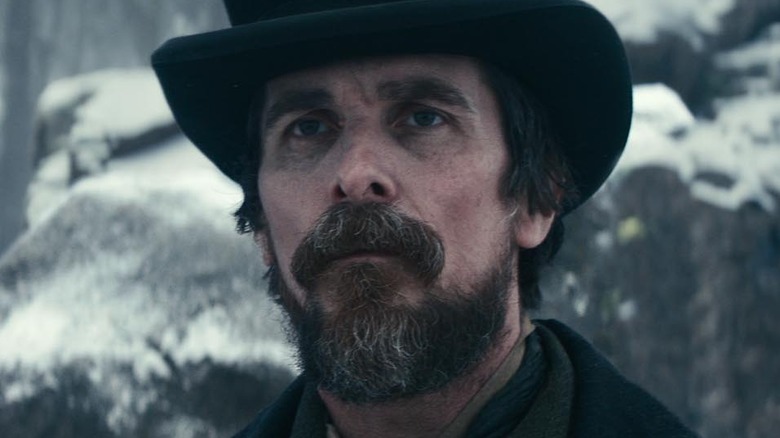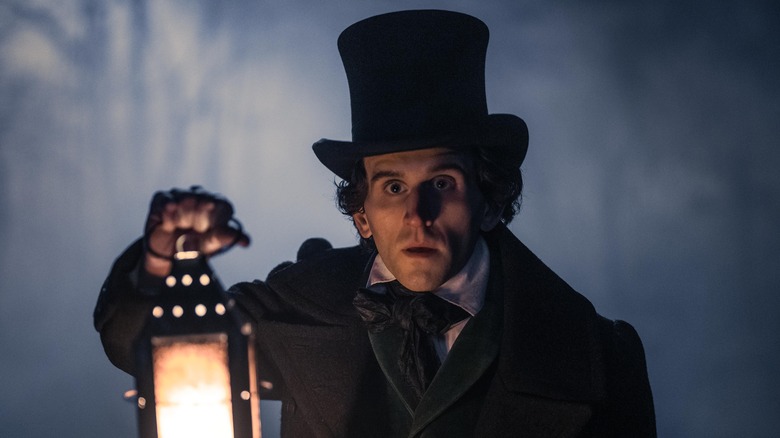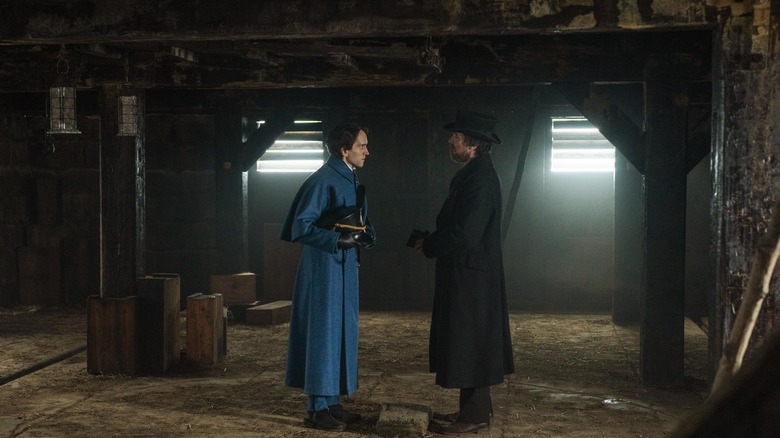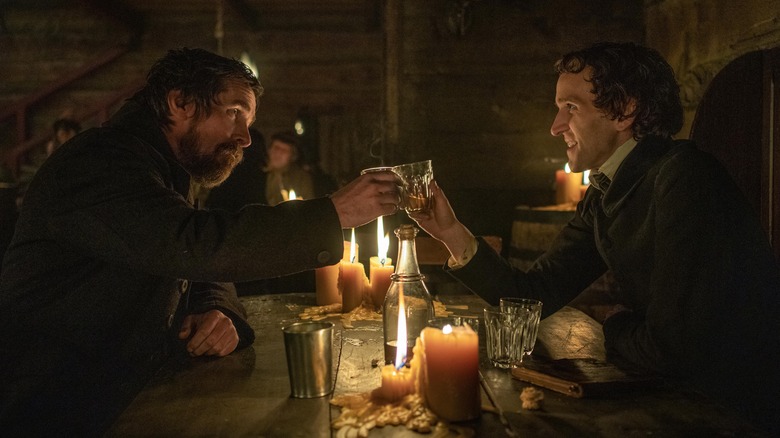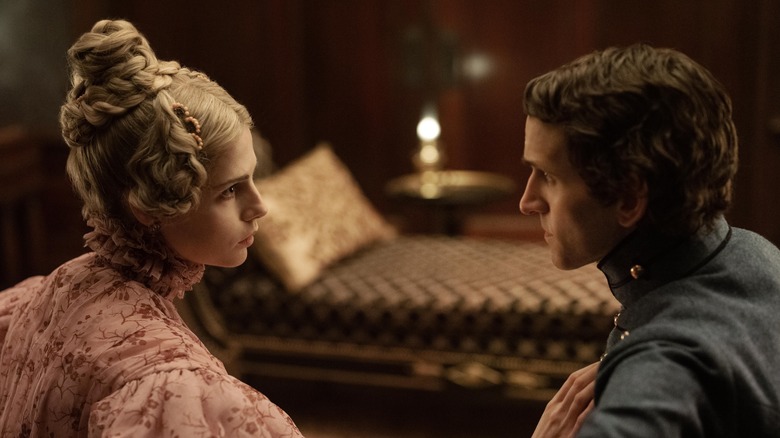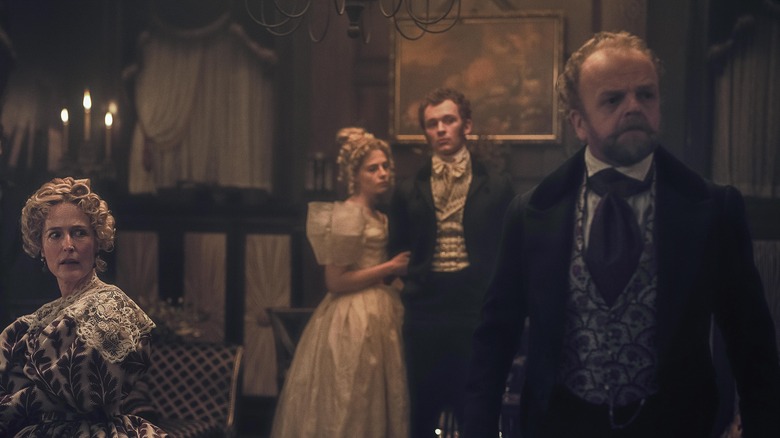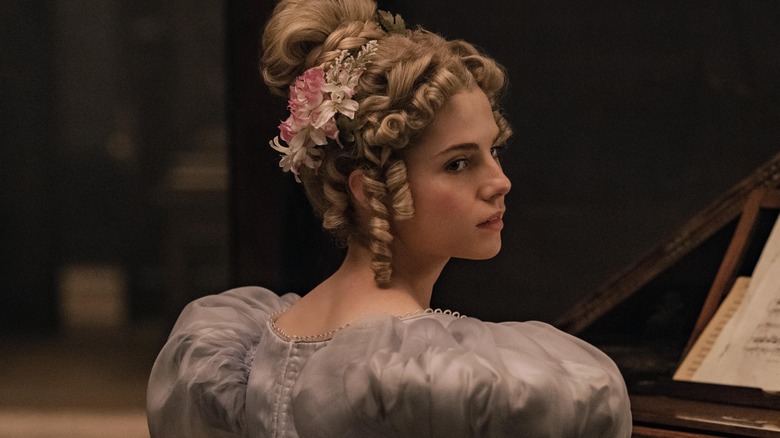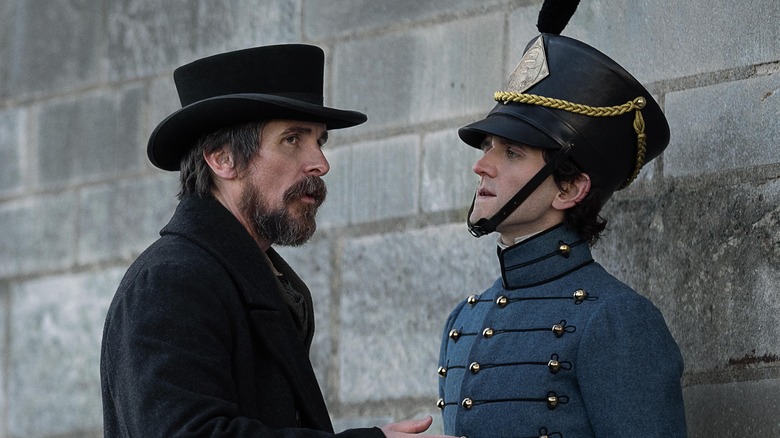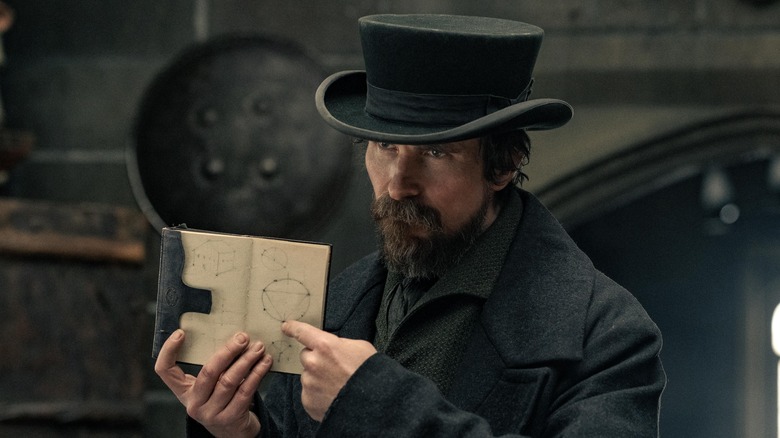The Biggest Differences Between The Pale Blue Eye And The Novel
This post contains spoilers for "The Pale Blue Eye."
Steel your hearts and hearken well, dear reader, for Netflix is now streaming "The Pale Blue Eye," a tense, brooding, mystery worthy of its celebrity costar: a young Edgar Allan Poe (Harry Melling). The atmospheric whodunit unravels thanks to Poe and the grizzled Manhattan detective Augustus Landor (Christian Bale), whose brilliant minds work together to twist and re-twist the story like a rag being wrung of blood. The tale, a work of historical fiction inspired by Poe's brief stint at the famed West Point Military Academy, is an adaptation of a novel by the same name, expertly written by Louis Bayard. Much of what you'll see in the movie is ripped directly from Bayard's pages, and then again, a great deal of it is new.
Among the differences between the novel and film, most are small and just byproducts of condensing a 400+ page book into a two-hour movie, but a few are large enough to leave the two versions both unique and uniquely entertaining. While the movie wins points for streamlining aspects of the otherwise-lengthy plot, the book is able to get away with more graphic depictions of romance and violence, and both versions boast their own takes on the relationships between Poe, Landor, and the other main characters. Read on for the largest of these alternate takes as we explore the biggest differences between "The Pale Blue Eye" and the novel.
Poe
You might recognize the actor behind Poe right away, yet anyone would be forgiven for failing to place his face — it's Harry Melling, whose most famous role to date was Dudley Dursley, Harry's loathsome, bullying cousin in the "Harry Potter" movies. In "The Pale Blue Eye," Melling is noticeably older, taller, thinner, and perhaps most strikingly: an excellent actor. Melling brings Poe to life, but it's worth noting that the movie's version of Poe differs from the novel's by a full Baltimore acre.
The movie presents Poe for the most part as meek, timid, and restrained — a pale, frail, bullied young cadet whose constant torment has forced him to retreat inward to his mind and art. It's a very different story for the book version; or more accurately, versions. The book Poe is actually many Poes. He habitually lies about his past, giving Landor and others a new backstory almost every time he's asked, and the deception becomes such an issue for Landor that he has a detective associate of his in New York run a background check on Poe. Curiously, the one thing that every version of Poe seems to have in common is a bold, brash, social flare — the one trait that the movie Poe seems to consistently lack.
The icehouse, the crypt
It may not seem like much of an important change at first, but the movie's choice to switch around the locations of the crimes and investigation give the story a decidedly different rhythm and tone. In the novel, the initial desecration of Leroy Fry's body is thought to have occurred right outside the ice house, where the body was (re)discovered. After the coroner, Dr. Marquis (Toby Jones), confirms that ice would be needed to keep the heart intact, the icehouse rests in the forefront of readers' suspicions for almost the entire book. The cinematic "The Pale Blue Eye" wisely leaves the icehouse out of the investigation until later, instead placing the desecration in the coroner's office. The end result is a bigger reveal when Landor finally investigates the house and discovers the traces of a magic circle, opening up the supernatural side of the case.
Likewise, the movie keeps the climactic final rescue of Poe from the clutches of the Marquis family in the icehouse, adding even further importance to the site. The book, however, takes the final rescue and subsequent conflict a step deeper (literally) by forcing Landor to discover the real scene of the dark rituals: the old, abandoned tunnels beneath the ice house, pitch black and covered from wall to wall in the bones of long-dead animals. The overall effect is a far more sinister, visceral finale to the Marquises' magic.
Father and son
The film's portrayal of the relationship between Landor and Poe is effective (and upon review, arguably one of the movie's best parts), but it almost entirely skips one of the biggest and best parts of the book: the gradual buildup of a genuine father-son relationship, one they both desperately need.
The movie only truly touches on this dynamic at its very end, when a regretful Landor wonders how much better life would have become if Poe had somehow met and married Landor's daughter Mathilde (Hadley Robinson). The book, on the other hand, dives into this hypothetical early and often. The height of this dynamic, at least emotionally, comes when Poe's childhood foster father, John Allan, comes to visit the boy at West Point.
Allan, sick of Poe's lifestyle and alleged lack of character, has come to the academy to cut the boy off from financial support, and to tell him off. In a fit of defensive rage that surprises even himself, Landor slams Allan against the wall and hisses at him, "You bastard. He's worth a hundred of you." Then Landor, always the self-deprecating old sot, releases him and adds gently, "If it's any consolation, Mr. Allan, he's worth a thousand of me."
Lea's loves
If you've only seen the big screen adaptation of "The Pale Blue Eye," you may have come away with the impression that the beautiful Lea Marquis (Lucy Boynton) is a shy, sweet young woman, apart from the Satanic sacrifices. She speaks only rarely, and when she does, it is almost always to say something kind to her family or defend Poe from ridicule. In a few major ways, the novel Lea is the exact opposite: her magic may not be quite so black (which we discuss elsewhere in this article) and her demeanor is certainly not so pure.
The Lea in the novel is anything but shy; she almost impulsively uses her beauty and sexuality to manipulate those around her, including Poe, Landor, and even her brother Artemus (played by Harry Lawtey in the film). Though the movie Lea only rarely, casually speaks with Landor, in the novel Lea repeatedly finds him when he's alone and flirts with him, at one point even making a blatant offer to exchange sex for Landor's promise not to investigate her brother.
Likewise, Lea turns her genuine mutual attraction to Poe into manipulation by insisting that they become engaged, only to make him feel beholden to her every desire — including allowing himself to be ritually sacrificed for her health.
The Marquis family magic
The film "The Pale Blue Eye" distills the history of the Marquis family and their magical connections down into a simple backstory: they're descended from the infamous witch hunter Henri le Clerc, who turned to the dark arts before he died, passing his knowledge down to the family. As far as Landor, Poe, and occult expert Jean Pepe (Robert Duvall) are concerned, le Clerc was evil and so are his descendants, the Marquises, which is why they've resorted to murder and stealing organs from bodies.
Louis Bayard's pages manage to develop the storyline in greater detail, however, and add a good amount of complexity and uncertainty to the Marquises' history and motivation. Firstly, Dr. Marquis reveals that le Clerc tried using forbidden magic merely to heal those whose traditional medicine had failed, which is what prompted Lea to try the same for herself. Even once Lea had begun her rituals meant to cure herself of the sleeping sickness, her only victims were animals — hence the field of bones in the tunnels beneath the ice house — and never humans. On top of that, Dr. Marquis was never even aware of the specifics of Lea's actions, just that she had begun studying le Clerc's writings and trying to replicate his methods.
Lea's death
For both Marquis siblings, Lea and Artemus, their deaths in "The Pale Blue Eye" movie are far kinder and far more censored than their book counterparts. In the film, the pair are given the gift of dying off-screen (at least, for the most part), lost together in the smoke and rubble as the ice house burns and collapses to the ground. It's a bittersweet resolution, one that sees them receive their due justice but maintain a portion of their honor. The novel treats their deaths very differently, and it may be the single biggest — or at least most alarming — change between the two adaptations.
In the novel, after Lea's attempt to sacrifice Poe is thwarted, she desperately scarfs down the dis-attached heart of Fry, and in her haste, begins to choke. Trying to save her by any means, Artemus gives her an impromptu tracheotomy, which fails utterly. Lea begins spraying blood from her neck and after a few horrifying moments and tragic gurgles, she dies. With his sister (and potentially, true love) dead by his own hands, Artemus decides to take his own life in an equally brutal way. Using the same tracheotomy knife, he stabs himself in the side, causing him to rapidly lose blood until his eventual death, just as his sister had just experienced.
If you or anyone you know is having suicidal thoughts, please call the National Suicide Prevention Lifeline by dialing 988 or by calling 1-800-273-TALK (8255).
Poe vs. Landor
Surprisingly, the novel features a well-known trope from buddy movies which the actual movie leaves out. In a huge portion of buddy stories, be they buddy comedies, buddy cops, or any other style, tensions between partners eventually boil over and force the two apart, threatening to do so forever. That's exactly what happens to Poe and Landor in the novel, and yet it didn't make it into the film.
In Louis Bayard's novel, the emotional separation between the two men not only serves a narrative purpose but also a specific purpose for Landor: needing to meet justice after his vengeful murders are through, the detective deliberately pushes Poe away in order to grant the young poet the objectiveness and clarity he will need to finally deduce Landor's crimes. It's an effective way to keep us on Landor's side after his brutal spree is revealed, and even more so at its climax.
Putting his money where his mouth is, Landor offers Poe a loaded pistol and urges the poet to shoot him. It's both the lowest moment in their relationship and its highest — at that point, the pair have never had more animosity for each other, and certainly, neither has ever come so close to killing the other, but this is also the most amount of trust Poe has ever received, from Landor or anyone else. Sadly, the film cuts the entire scene, and even the whole rift preceding it.
Landor's clues
There's a reason Christian Bale recommends seeing "The Pale Blue Eye" a second time: once the final twist is revealed, once viewers finally realize that Landor committed the murders, a number of his actions and lines of dialogue in the film begin to make more sense. On a second viewing, so much of Landor's inexplicable sourness and single-mindedness stop confusing and start contextualizing. But for all the clues hidden in the movie that point to Landor's involvement, the book has tenfold more.
For one example, the matter of Landor's pay is brushed over in the film, leaving only the most diehard logic-seekers to question why the detective would choose to work for free. In the book, Landor's refusal is mentioned in greater length, prompting some characters to hail him as heroic and some readers to wonder at his awkward refusal of honest pay.
Following that, dozens, if not hundreds, of little clues arise to vex observant readers. When a young cadet describes the condition of a freshly-hanged Fry's body as "not well," Landor has to strain to avoid laughing out loud, which takes on a whole new light (or darkness) once we understand that Landor himself did the hanging. Interviewing that same cadet, Landor also presses him to recall many specific details, but when the cadet tries to recall the look or sound of the perpetrator, Landor immediately waves him off, telling him "I beg of you, don't start kicking in the spurs. It's no surprise you can't get at ... all the excitement, all the running about, it tends to rattle a fellow's brain."
